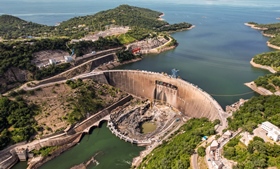Works on the US$294.2 million United States Dollar Kariba Dam Rehabilitation Project (KDRP) are progressing well with works being at 67 percent complete.
Zambezi River Authority Chief Executive Officer (CEO) Munyaradzi Munodawafa said in a press statement to ZANIS that the project, which comprises three components, the Reshaping of the Plunge Pool, Refurbishment of the Spillway upstream control facility and institutional strengthening, is projected to be completed by the first quarter of 2025.
Mr Munodawafa said KDRP will help to address dam safety concerns and restore the structural strength of the Kariba Dam for its long-term reliability and safety of operation.
He said since construction, the Kariba Dam has served Zambia and Zimbabwe for over 60 years.
The CEO noted that the Plunge Pool Reshaping works contract, which is being undertaken by Razel Bec (a French company), commenced in May 2017 and works, is now at 78 percent complete.
He said works on the plunge pool reshaping will be completed in the second quarter of 2024.
“In total, 680 million litres of water have been pumped out of the Plunge Pool, leaving the current water level in the pool at 320m Above Sea Level (ASL). Pumping out of the water, with the resulting lowering of the pool level, paved way for the excavation works using controlled blasting of the exposed rock,” he said.
Mr Munodawafa disclosed that to date, approximately 137 000 cubic metres of rock has been removed, out of a total of 300,000 cubic metres.
He said excavation works will widen the Plunge Pool in keeping with the technical design of removing the rock mass around the Plunge Pool of the dam, haulage, and disposal of the excavated rock at the designated dumpsite.
The spillway refurbishment works contract commenced in November 2019 and is being implemented by the Authority as the Employer and a Consortium of GE Hydro France with Freyssinet International as the Contractor.
Mr Munodawafa noted that the status of the project is that the works are at 57 percent complete and the target date for completion of the Spillway Refurbishment works is expected to be completed by the first quarter of 2025.
“This project involves the replacement of defective guiderails on the upstream spillway control facility to improve the operations of the six sluice gates,” Mr Munodawafa said.
He said the contractor is focusing on the hydro-demolition of the secondary concrete around the old Built-in-Parts (BIPs) upstream of the Sluices, repair of surface cracks on the downstream end of sluice number three and finalisation of the manufacture of the Emergency Gate in China and the Gantry Crane in South Africa.
Mr Munodawafa said the Authority engaged the services of Gruner Stucky Limited (a Swiss company) as the technical services and supervision consultant for the KDRP.
He pointed out that owing to the unprecedented nature of the works components of the KDRP, the Authority is further supported by a seven member Dam Safety Panel of Experts (DSPoE) which undertake bi-annual site visits and provided guidance, recommendations and opinions to help resolve project execution challenges.
The KDRP Project is being funded through grants and loans made available to the Zambian and the Zimbabwean Governments by the African Development Bank; the European Union; the Government of Sweden and the World Bank.
Mr Munodawafa disclosed that the authority also contributed counterpart funds on behalf of the Governments of Zambia and Zimbabwe.
The Zambezi River Authority CEO said KDRP is to ensure the continued strengthening of the Kariba Dam wall.
He said completion of the KDRP works will benefit the communities in both Zambia and Zimbabwe through a safer and reliable management of flood releases to avoid overtopping of the Dam Wall.
“This will also minimize the risks of unregulated releases of water which could flood the downstream communities, resulting in damage to property and considerable loss of lives, under worst case scenarios,” He said.
Mr Munodawafa noted that a strong Dam wall will continue to provide sustainable management of the impounded water to ensure continued availability of water for hydropower generation which is a critical part in the socio-economic development of Zambia and Zimbabwe.



Ni incompetence chabe. Rehabilitation takes six years! Yet construction took three years. Who is to blame Governments ot engineers?
Comments are closed.